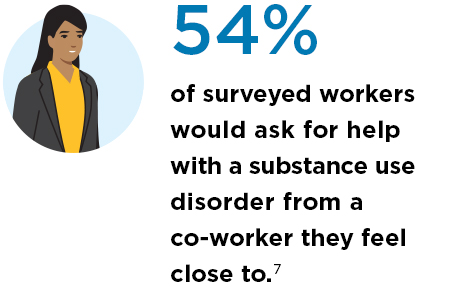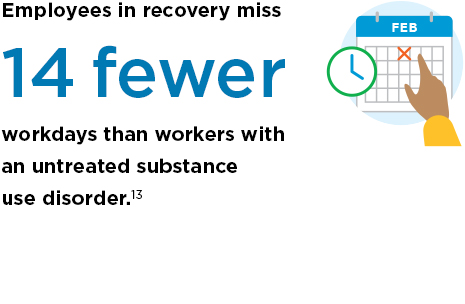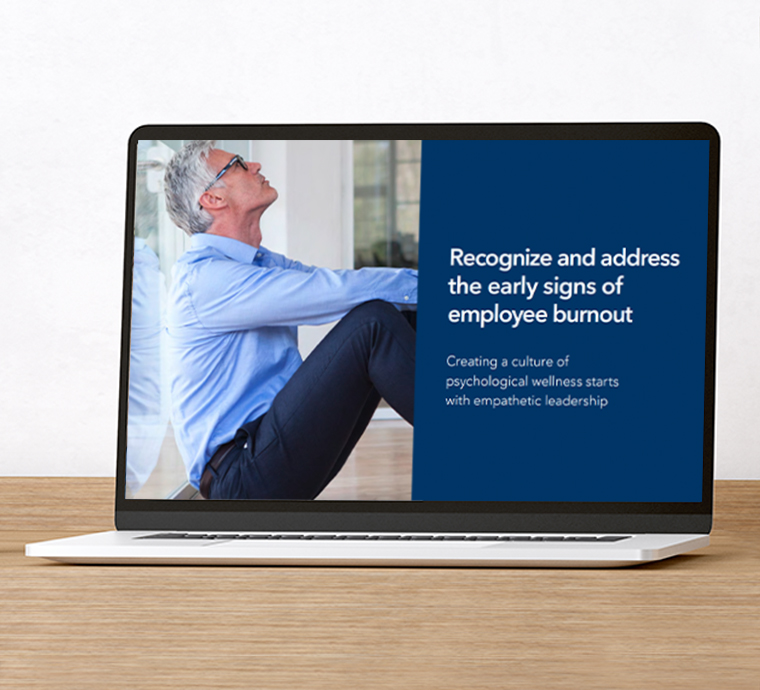
While many employers prioritize the well-being of their employees, workplace policies often overlook addiction and substance use disorders — which can perpetuate stigma and hinder support for employees who need it. To address this, creating recovery-supportive workplace programs can reduce barriers, promote treatment, and foster a culture of understanding and compassion.
Substance use is prevalent in our modern culture, and millions of Americans experience substance use issues.1 In fact, roughly 2 in 3 adults with a substance use disorder are employed.2 They’re our colleagues, leaders, or ourselves. Most of those who are not yet engaged in support would benefit from it, but enduring stigma often prevents them from seeking help.
It’s important that workplaces take steps to support workers in recovery and those looking to reduce their use. Investing in substance use disorder treatment can improve the lives of your employees and yield significant cost benefits. Every dollar invested in treatment saves $4 in employer health care costs.3 By building a recovery-ready workplace, business leaders can reduce their health care spending — while helping employees improve their health and maximize their potential.


Substance use disorders can effect anyone
Substance use affects people of all demographics and backgrounds. Our environment, the support we receive, and people’s attitudes toward substance use all influence how we engage with substances.
As with any health condition, people who suffer from substance use disorders deserve compassion and care. Unfortunately, stigma can force employees to hide their condition, rather than getting support. Erika Aguirre-Miyamoto, a licensed clinical social worker with Kaiser Permanente, explains that “they sometimes don’t want to admit that they’re not functioning at 100%. They may feel guilt, and fear of judgment or reprisal if they were to ‘out’ themselves by seeking treatment. They can end up isolated, which exacerbates their condition.”

“Life circumstances and even genetics can put people at a higher risk for developing a substance use disorder. If a person doesn’t have access to support, they may turn to self-medication to cope.”
— Erika Aguirre-Miyamoto, a licensed clinical social worker at Kaiser Permanente

Conversely, if employees feel safe enough to be open with their employer when they need help, they’re more likely to shift their substance use choices and behaviors. 54% would feel comfortable asking for help with a substance use problem from a co-worker they felt close to.6
By creating a culture of trust and support in the workplace, more employees can get needed treatment — and employers can retain strong, dedicated teams.
Supporting employees in recovery is a smart investment
As an employer, your support can help remove barriers to behavior change and recovery — and reduce health care spending, lost productivity, and turnover costs.
Addiction and substance misuse add up to an economic toll of over $740 billion per year.8 Workers with an untreated substance use disorder are more likely to have unplanned absences, missing over a week-and-a-half more than their peers annually.9 They can also cost over $8,000 in additional turnover, absenteeism, and health care spending each year, per employee.10 For executive-level employees, that number ranges as high as $15,000.11
However, evidence shows that workers in recovery tend to stay in jobs longer and are less likely to be hospitalized compared with those with an untreated substance use disorder. They miss 14 fewer workdays each year than workers with an untreated substance use disorder, and 4 less days than an average employee.12

How employers can create a recovery-ready workplace

A healthy workforce doesn’t come from policy alone — it takes deliberate steps to create a culture that employees feel safe and respected in, and to break the notion that employees who struggle with addiction have to hide their condition.
“The goal is to reduce harm,” Aguirre-Miyamoto says. “Punitive policies, forced leave, and suspension aren’t always helpful. We’ve all heard that you have to ‘hit rock bottom,’ but that’s not necessarily true. We don’t want employees to hit rock bottom at work. We want early intervention and prevention so it doesn’t get to that point.”
Create an inclusive, emotionally supportive workplace
Stressors like grief, injury, and even burnout at work can happen to anyone. They can lead to coping through substances, which can develop into substance misuse. It’s easy for people who are experiencing stressors or substance use to feel isolated and alone, so it’s important that employers create an inclusive and emotionally supportive environment for all employees.
Use the right words — Aguirre-Miyamoto says to “talk the talk and walk the walk.” Center and respect your employees by using language that doesn’t label or define them in relation to a condition.
- Use person-first terms: for example, “person with a substance use disorder,” rather than pejorative terms like “addict.”
- Use empathetic phrasing: “What are you struggling with?” rather than “What’s wrong with you?”
Provide trainings — Managers and employees alike can benefit from trainings to recognize signs of addiction, provide support, and identify and eliminate personal bias around addiction. More broadly, mental health awareness trainings can empower leadership to support their teams’ total health and wellbeing.
Address difficult working conditions — It goes without saying that employees should be safe in their work, but for industries that are physically or mentally taxing, work-related pain, injury, and illness can lead to substance misuse. Reducing conditions that could be harmful, encouraging work-life balance, and providing stress management resources can help mitigate unnecessary strain.
Consider workplace culture — Is there often alcohol served at company events? Offering mocktails, encouraging responsible drinking, limiting open bars, and holding social events that don’t center around or include alcohol can help make your workplace more inclusive and normalize socialization without substances.
Support behavior change and recovery
Offer health benefits for recovery — Comprehensive health care options can make all the difference for an employee seeking help. Employee assistance programs and peer support programs are also valuable offerings, as are informal accommodations like flexible work schedules and time off for treatment. Inform employees about relevant resources available through your organization or their union.
Be clear about substance use policies — Employers can create an open dialogue about the substance use policies in their office and industry and share the written policies directly with their workforce. The policies should clearly define and communicate second-chance act policies, return-to-work programs, and other protocols. In addition, employers should make it clear that employees can come to management for support.
Hire and retain employees in recovery — Facilitate return-to-work plans for employees who have taken leave for treatment, and be supportive of their recovery. Extend employment opportunities to people who are in or seeking recovery. The federal government offers tax credits and programs that incentivize businesses for hiring people in recovery, and the U.S. Department of Labor provides a Recovery-Ready Workplace Toolkit.
Building trust to create stronger, healthier teams
By taking steps to foster and sustain a recovery-ready workplace, employers can create a culture of support that pays dividends — in terms of employee well-being, as well as financially. Employers curate their health plan benefits, their workplace environment, and their company culture. Their policies can be a significant source of support for people with substance use disorders — or a hurdle to behavior change and recovery. Consider how your company culture can support the health and belonging of your employees, and how your policies can help create a recovery-ready workplace.
Recognize and address the early signs of employee burnout
Discover what can cause burnout and how to create a culture better equipped to manage stressors.

About our expert

Erika Aguirre-Miyamoto is the director of operations for Kaiser Permanente’s Southern California Regional Behavioral Health Department. Prior to joining the regional team, she was a department administrator for the Addiction Medicine, Center for Healthy Living, and Neurology departments at Downey Medical Center. She came to Kaiser Permanente from the nonprofit sector, where she worked as clinical director and chief programs officer of a community organization providing services to people experiencing homelessness, substance use, and mental health issues in Los Angeles.
Additional resources you may find helpful



- 1
“2022 Workplace Recovery Survey Report,” forsmarsh.com, accessed April 16, 2024.
- 2
Michael R. Frone et al., “Workplace Supported Recovery from Substance Use Disorders: Defining the Construct, Developing a Model, and Proposing an Agenda for Future Research,” National Library of Medicine, May 18, 2023.
- 3
Surgeon General’s Report on Alcohol, Drugs, and Health, 2017.
- 4
See note 2.
- 5
See note 3.
- 6
See note 1.
- 7
See note 1.
- 8
See note 1.
- 9
“Substance Use Disorders By Occupation,” National Opinion Research Center at the University of Chicago, accessed April 11, 2024.
- 10
See note 9.
- 11
See note 9.
- 12
“New Analysis: Employers Stand to Save an Average of $8,500 for Supporting Each Employee in Recovery from a Substance Use Disorder,” National Opinion Research Center at the University of Chicago, accessed April 11, 2024.
- 13
See note 12.
Kaiser Permanente health plans around the country: Kaiser Foundation Health Plan, Inc., in Northern and Southern California and Hawaii • Kaiser Foundation Health Plan of Colorado • Kaiser Foundation Health Plan of Georgia, Inc., Nine Piedmont Center, 3495 Piedmont Road NE, Atlanta, GA 30305 • Kaiser Foundation Health Plan of the Mid-Atlantic States, Inc., in Maryland, Virginia, and Washington, D.C., 2101 E. Jefferson St., Rockville, MD 20852 • Kaiser Foundation Health Plan of the Northwest, 500 NE Multnomah St., Suite 100, Portland, OR 97232 • Kaiser Foundation Health Plan of Washington or Kaiser Foundation Health Plan of Washington Options, Inc., 1300 SW 27th St., Renton, WA 98057
Congratulations! You have successfully saved this item.
To access your Saved items any time, open the "Saved Items" folder in the top right corner of the page.
It seems that you do not have cookies enabled. Please enable cookies to make use of all of our site's functionality.
You haven't collected any items yet.
- Save Content
Click the "Save" icon next to the content you want to revisit later.
- Access Your Saved Items
Click on the "Saved Items" link at the top of the page or use the URL we create for you.
Be sure to copy and paste the URL we create for you before you leave the site.
1-5 of 14
Your Link
After leave the site, your saved items will be saved for you at this URL:
https://business.preview.dpaprod.kpwpce.kp-aws-cloud.org/saved-items?user=Share your list
Show Disclaimer +


